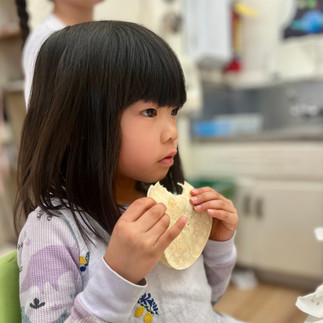
How do children perceive themselves?
One of the ways we can find out is through their self-portraits. Depicting oneself in art starts in preschool, and the first portrayal of self often looks like a jellyfish, a circle with two floating lines emerging from the bottom. We can start even with those primitive drawings to ask “Is that you?” “What are you doing?” We don’t want to point out what’s missing—“Where are your arms?”—but to cheer as new body parts emerge with developmental maturity. It’s interesting that these shapes are common to every culture. Getting children to talk about their ideas of self is the beginning of the exciting process of creating self-identity and awareness of others.
If you peek into the elementary art center (Room 16), you’ll notice that the room abounds with self-portraits, including a crowd of three-dimensional heads. One reason for our school-wide learning objective of children to learning to express themselves through the arts is that children need flexible, creative ways to explore their evolving sense of self. Without art, they would be left with their reflection in the mirror and the perceptions of how they think others see and judge them.
Our wonderful elementary art teacher, Lara Cannon, continuously finds fascinating and meaningful ways to engage children in this self-identity process. With first-graders, Lara blindfolded a teddy bear and asked the children to draw themselves so the bear could see what they looked like when the blindfold was removed. That was part of their ongoing love fest with the bear. Lara copied their portraits on a roll of paper in black ink, then asked them to color in their illustrations to create a large mural, which allowed the children to see themselves in relation to others.
Lara asked the second graders to explore their self-portrayal though painted paper collage, an exercise that included mixing their own hair and skin colors. She encouraged the students to include their dreams for the future in the collages.
Preschool has stimulating self-portrait activities too. One of the most popular occurs annually with the reading of The Color of Us and students mixing their unique skin colors. These are often full-body portraits, starting with the teacher tracing around the student’s body, then having them fill in their hair, facial features, and clothes. Like the display of second grade collages in Room 16, these large preschool representations of all the students creates a powerful picture of diversity.
Creating self-portraits can be a fun and satisfying family activity. Instead of trying for realism, family members can create fantasy portrayals of themselves, reflecting things they would like to do or qualities they want to develop in the future. Whatever the setting, we want to applaud children’s bravery in creating their identity through art, no matter what their level of skill.























































